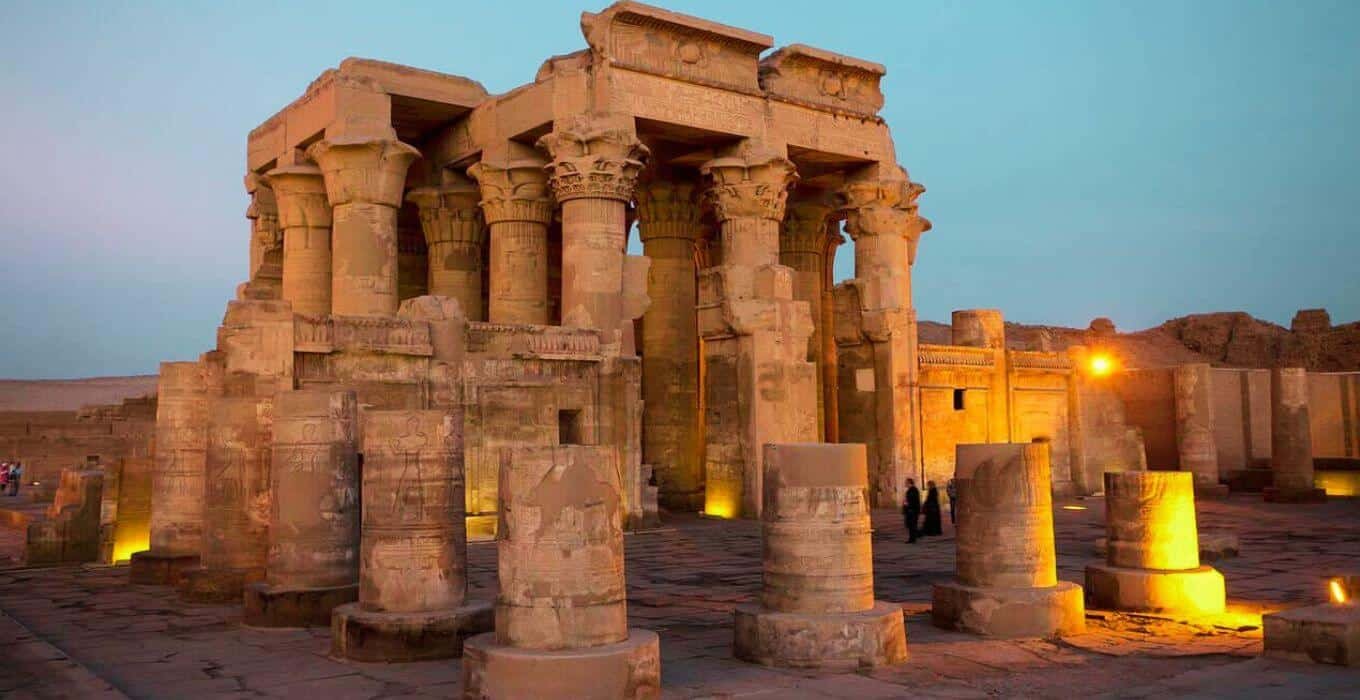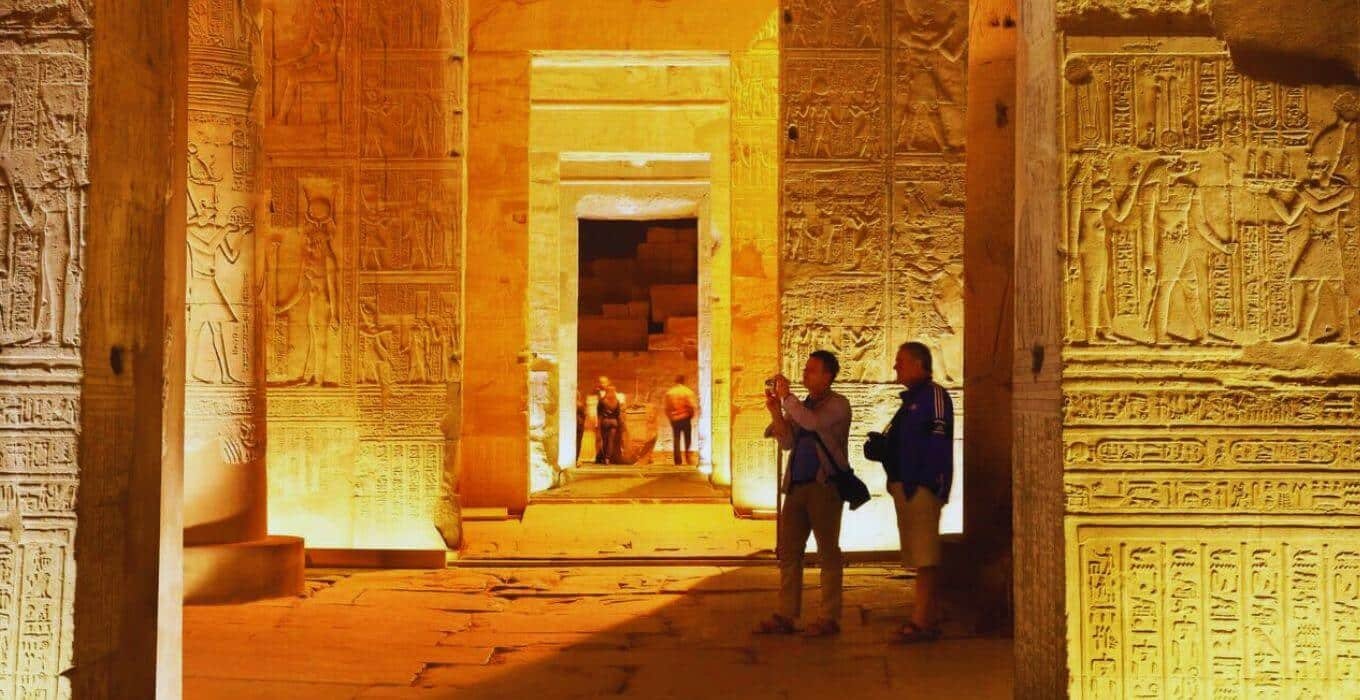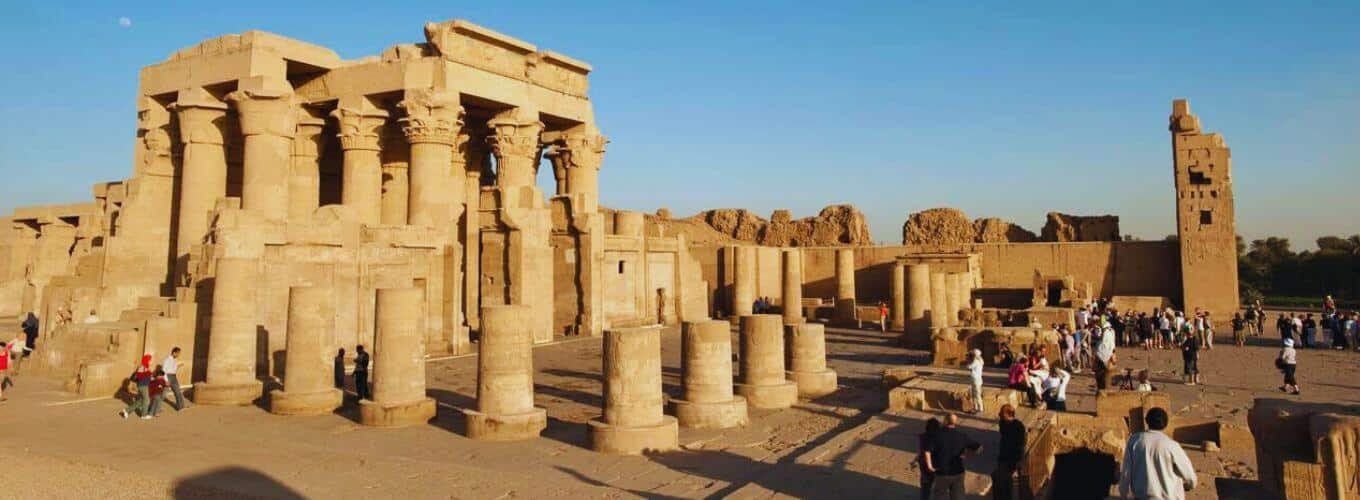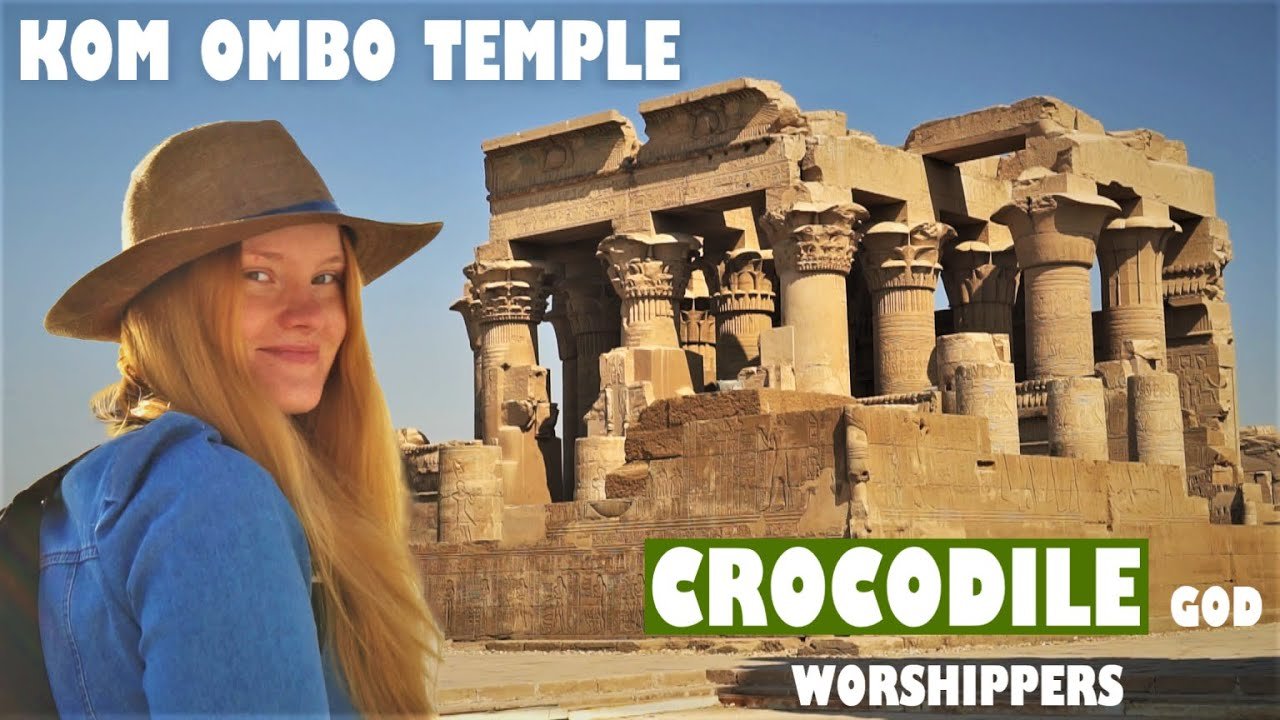The Kom Ombo Temple sits on the Nile River’s banks, showcasing ancient Egypt’s architectural and cultural genius. This ancient wonder, from the Ptolemaic era, takes visitors on a journey through time. It uncovers the complex history of Egypt. But what mysteries hide in its detailed walls? What can it teach us about ancient Egyptian beliefs and practices?
Key Takeaways
- The Kom Ombo Temple is a unique dual sanctuary dedicated to two deities: Sobek, the crocodile god, and Horus, the falcon-headed god.
- The temple’s architecture showcases the grand scale and intricate design of Ptolemaic-era structures, with towering pylons, exquisite hieroglyphic inscriptions, and a captivating dual design.
- Situated along the Nile River, the Kom Ombo Temple offers a glimpse into the ancient Egyptians’ deep connection with the life-giving waters and their reverence for the natural world.
- The temple’s preservation and ongoing conservation efforts highlight the importance of safeguarding Egypt’s cultural heritage for future generations to explore and appreciate.
- Visiting the Kom Ombo Temple provides an immersive experience, allowing travelers to step back in time and gain a deeper understanding of ancient Egyptian religion, architecture, and the fascinating Nubian influences in the region.
Exploring Kom Ombo: A Timeless Treasure
The Kom Ombo Temple is a stunning site along the Nile River. It has amazed visitors for centuries. This temple is special because it honors two gods: Sobek the crocodile and Horus the falcon.
It was built during the Ptolemaic era. The temple’s design shows the Egyptians’ skill in architecture. Its unique layout is a testament to their creativity and precision.
When you visit, you can see the detailed hieroglyphics on the walls. These tell stories of the gods and the rituals held there. They give us a peek into the ancient Egyptians’ beliefs and traditions.
|
Significance of Kom Ombo Temple |
Key Features |
|
|
The Kom Ombo Temple is a key spot for archaeological tourism in Egypt. It offers a unique experience. Visitors can explore its structures and learn about the Nile River’s rich history.

Kom Ombo Temple: A Unique Dual Sanctuary
The Kom Ombo Temple in Egypt is a remarkable site. It’s known for its unique design. This ancient temple was dedicated to Sobek, the crocodile god, and Horus, the falcon-headed god.
The Intricate Dual Design
The temple’s design shows its dual nature. It has two sets of rooms and columns, mirroring each other. This layout lets visitors see the rituals and beliefs of Sobek and Horus. It gives a peek into Ancient Egyptian religion.
Honoring Sobek and Horus
The temple’s dual deities shrines are filled with hieroglyphic inscriptions. These honor Sobek and Horus. Sobek, the god of fertility, was linked to the crocodile. Horus, the sky god, was represented by the falcon.
The balance between Sobek and Horus in the Kom Ombo Temple design is unique. It offers visitors a chance to dive into Egypt’s rich culture.
Architectural Marvels of the Ptolemaic Era
The Kom Ombo Temple shows the skill of the Ptolemaic Dynasty. They ruled Egypt during the Hellenistic period. The temple’s big gateways and tall pylons are impressive, showing the Ptolemaic’s talent in design and building.
Grandiose Gateways and Towering Pylons
When you visit the Kom Ombo Temple, you’re struck by its size and beauty. The gateways and pylons are huge, with detailed hieroglyphic inscriptions. They were the main entrances, showing the temple’s grand architecture.
Exquisite Hieroglyphic Inscriptions
The temple’s walls are covered in beautiful hieroglyphic inscriptions. They tell stories of ancient Egypt. Scenes of religious rituals, mythological figures, and daily life in the Nile Valley are shown. These carvings give a glimpse into the rich history of these Egypt Historical Sites.
|
Architectural Feature |
Description |
|
Kom Ombo Temple Gateways |
Towering, ornate entrances that welcome visitors to the sacred site, showcasing the Ptolemaic’s mastery of Ptolemaic Architecture. |
|
Kom Ombo Temple Pylons |
Imposing, multi-tiered structures that flank the temple’s main entrance, adorned with intricate Hieroglyphic Inscriptions. |
|
Hieroglyphic Inscriptions |
Detailed carvings that adorn the temple walls, depicting religious rituals, mythological figures, and everyday life in ancient Egypt. |
The Kom Ombo Temple and the Nile
The Kom Ombo Temple sits on the banks of the Nile River. This spot has made it very important and attractive to visitors of Egypt’s historical sites. Its special bond with the Nile has made it a key Nile River monument and a top spot for archaeological tourism.
The temple’s close tie to the Nile adds to its beauty. It also influenced the rituals and ceremonies held there for centuries. The Nile’s flooding and life-giving waters are linked to the Kom Ombo Temple‘s spiritual and cultural importance. This shows the ancient Egyptians’ deep respect for nature.
Visitors to the Kom Ombo Temple see the temple’s beauty next to the Nile’s calm flow. This creates an amazing experience. The temple’s spot by the river has let many travelers see its timeless beauty. It helps them understand Egypt’s rich culture.
“The Kom Ombo Temple’s lasting bond with the Nile River shows the ancient Egyptians’ deep respect for nature. They were able to blend their architectural wonders with the landscape.”
Exploring the Kom Ombo Temple, visitors are drawn to its architecture and its connection to the Nile. This connection is a key part of this archaeological tourism site. The temple’s location by the river shows the ancient Egyptians’ knowledge of their environment. They built structures that blend well with nature.
Kom Ombo Temple: A Glimpse into Ancient Egyptian Religion
The Kom Ombo Temple is a window into ancient Egyptian spirituality. It was a place of deep rituals and culture during the Ptolemaic era. Dedicated to Sobek and Horus, it was a center of religious life.
Rituals and Ceremonies
Worshippers came to the temple for many rituals. They honored Sobek and Horus with elaborate ceremonies. These practices were key to their connection with the divine.
The temple’s inscriptions show the details of these rituals. You can see priests, priestesses, and worshippers in various activities. They mummified sacred crocodiles and performed fertility rites.
Symbolic Representations
The Kom Ombo Temple shows the Egyptians’ love for symbols. Its architecture and decorations are filled with symbols of Sobek and Horus. These symbols are of crocodiles and falcons, the gods’ forms.
- Towering columns with Sobek’s crocodile and Horus’ falcon carvings
- Elaborate inscriptions telling the gods’ stories and roles
- Statues and sculptures showing the gods’ unique qualities
These symbols amazed ancient worshippers and still do today. They give us a deep look into ancient Egyptian religion and culture.
Preserving Egypt’s Cultural Heritage
The Kom Ombo Temple is a symbol of Egypt’s rich history. It shows the importance of saving these treasures for the future. The Egyptian government and the world are working hard to keep these sites safe.
Conservation Efforts
Keeping the Kom Ombo Temple and other sites in Egypt is a big job. Teams of experts are working to fix and protect the temple. They focus on the architecture and the ancient writings.
There are also steps to keep these places safe from harm. This includes security, controlled entry, and managing visitors. These actions help protect the temple and other ancient sites from damage.
There are also efforts to teach people about Egypt’s history. This includes public campaigns and educational programs. They aim to make everyone understand and value Egypt’s cultural heritage.
|
Initiative |
Description |
|
Restoration and Maintenance |
Meticulous repair and upkeep of the Kom Ombo Temple’s architectural features and inscriptions by teams of experts. |
|
Protective Measures |
Comprehensive security systems, controlled access, and visitor management strategies to safeguard the temple and other sites. |
|
Educational Outreach |
Public awareness campaigns and educational initiatives to foster appreciation for Egypt’s cultural heritage. |
By focusing on saving the Kom Ombo Temple and other sites, Egypt shows its dedication. It’s a commitment to protecting its history and promoting tourism. This benefits both locals and visitors from around the world.

Kom Ombo Temple: A Must-Visit for Archaeological Tourism
If you love ancient Egyptian history and culture, you must see the Kom Ombo Temple. It’s by the Nile River and shows off Egypt’s past in amazing ways. This temple from the Ptolemaic era is a true marvel.
Planning Your Visit
Here are some tips to enjoy your time at the Kom Ombo Temple:
- Get there early to beat the crowds and take your time.
- Don’t forget a hat, sunscreen, and comfy shoes for walking.
- Consider a local guide to learn more about the temple’s secrets.
- Visit other sites like Edfu Temple or the Aswan High Dam too. It’s a great way to see more of Egypt’s history.
Exploring the Kom Ombo Temple will make you love ancient Egypt even more. It’s a key part of Egypt’s history and a big draw for those who love archaeology.
|
Recommended Duration |
Best Time to Visit |
Nearby Attractions |
|
1-2 hours |
Early morning or late afternoon |
Edfu Temple, Aswan High Dam, Elephantine Island |
“The Kom Ombo Temple stands as a testament to the ingenuity and rich cultural heritage of ancient Egypt, beckoning visitors to explore its timeless wonders.”
The Kom Ombo Temple and Its Nubian Neighbors
The Kom Ombo Temple in southern Egypt is a treasure of the country’s culture. It’s not just a marvel of architecture. It also has a deep bond with its Nubian neighbors, whose traditions have enriched the area for ages.
The Nubians, who lived by the Nile, have a long history with the Kom Ombo Temple. The temple’s close proximity to Nubian sites shows the cultural exchange and shared stories of this special area of Egypt Historical Sites.
Looking into the bond between the Kom Ombo Temple and Nubian sites reveals a rich heritage. The styles and beliefs of these ancient peoples often blended, creating a complex cultural scene. By preserving these Nubian Monuments, we learn more about the deep connections in this region’s past.
Protecting the Kom Ombo Temple‘s legacy is Egypt’s duty. The country must keep the cultural heritage of this site and its Nubian friends safe for the future. Through careful conservation and teamwork, Egypt can continue to uncover the shared history and importance of these ancient wonders.
Conclusion
The Kom Ombo Temple is a stunning Ancient Egyptian wonder. It shows the deep cultural heritage of this amazing land. This temple is special because it honors two gods: Sobek, the crocodile god, and Horus, the falcon god.
Visitors get to see the grand entrance and tall pylons. They also see beautiful hieroglyphics. These features highlight the skill of the Ptolemaic era’s architects and artists.
This temple is a key spot for those who love history and architecture. It lets travelers dive into Egypt’s rich past. Thanks to preservation work, the temple stays a vital part of Egypt’s history for all to see.
Whether you’re into history, architecture, or just exploring, the Kom Ombo Temple is unforgettable. It takes you back to ancient Egypt’s golden days.
Read other related articles:

